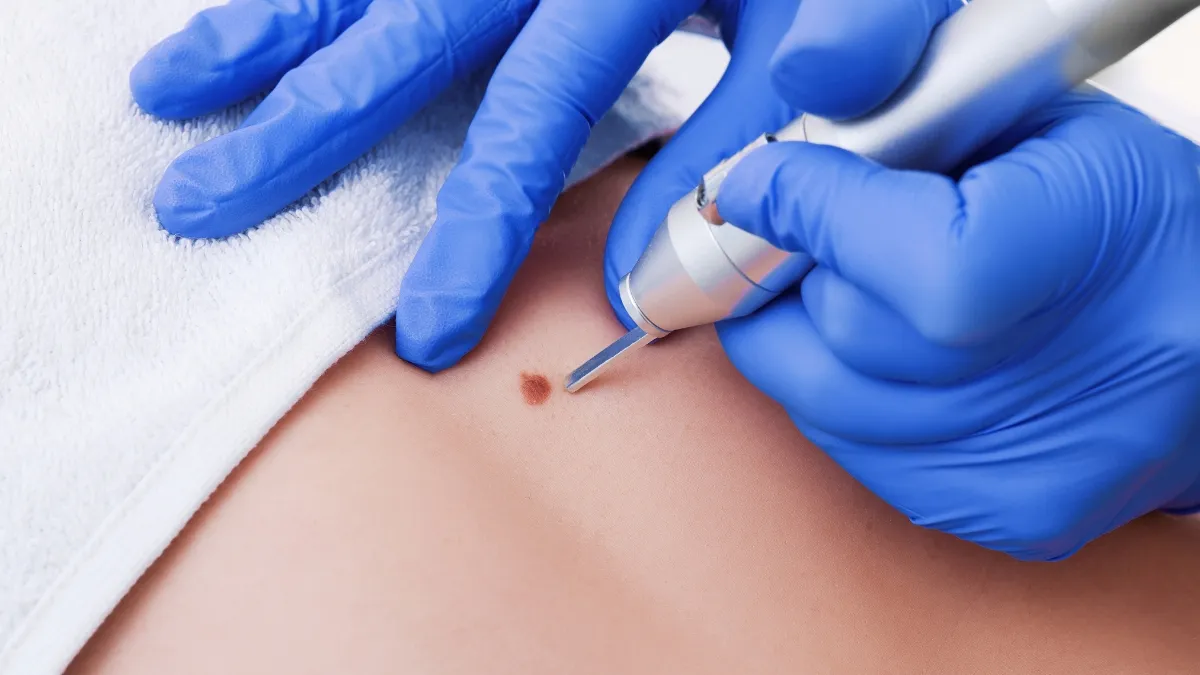Skin tags, DPNs (Dermatosis Papulosa Nigra), and seborrheic keratosis are common benign skin growths that can affect individuals of all ages. These conditions, while generally harmless, can sometimes cause cosmetic concerns or discomfort. Skin tag removal is often sought for aesthetic reasons, as these growths tend to appear in areas where skin rubs together, such as the neck, armpits, or groin. DPNs are particularly common in individuals with darker skin tones and typically appear on the face or neck, while seborrheic keratosis is more common with aging and tends to develop on the trunk, face, or shoulders.
What are DPNs, Skin Tags, and Seborrheic Keratosis?
DPNs, skin tags, and seborrheic keratosis are common skin growths that often appear as harmless, benign conditions.
- DPNs (Dermatosis Papulosa Nigra): DPNs are small, dark brown or black papules typically found on the face and neck, especially in individuals with darker skin. These small, round bumps are usually smooth and painless.
- Skin Tags: Skin tags are soft, flesh-colored growths that protrude from the skin. Often found in areas with frequent friction, like the neck, underarms, or groin, skin tags are usually harmless and painless, though they can occasionally become irritated.
- Seborrheic Keratosis: Seborrheic keratosis are non-cancerous growths with a waxy or scaly appearance. They can range from light tan to dark brown and are commonly found on the face, chest, and back. Although benign, these growths may resemble warts and can be cosmetically bothersome for some individuals.
Why do we get Skin Tags?
Skin tags, or dermatosis papulosa nigra, are benign growths influenced by genetics, hormonal changes, friction, and aging. They commonly appear in areas where skin rubs together, like the neck or armpits. While harmless, skin tags can vary in size and number and are more prevalent with age.
Can Skin Tags be Prevented?
While it may not be possible to completely prevent the development of skin tags, dermatosis papulosa nigra (DPNs), or seborrheic keratosis, some steps may help minimize their occurrence and reduce potential skin irritation:
- Maintain good skin hygiene: Keeping your skin clean and moisturized can help prevent irritation.
- Avoid excessive friction or irritation: Repeated friction, especially around skin folds, can lead to the formation of skin tags.
- Protect your skin from sun damage: Use sunscreen daily to reduce skin aging and potential growths.
- Regularly examine your skin: Check for any new growths or changes in size, color, or texture.
For seborrheic keratosis, consult a doctor if you notice any changes, such as bleeding or discomfort. An annual skin check-up is also recommended to monitor potential changes in skin growths.
How to remove Skin Tags?
Ray & Rio’s Speciality Clinic provides advanced, effective treatment options for safely removing DPNs, skin tags, and seborrheic keratosis. These techniques ensure minimal discomfort and excellent cosmetic results:
- RF Ablation: Radiofrequency ablation uses high-frequency electrical currents to remove skin tags without harming surrounding skin. This non-invasive method has minimal downtime and delivers natural-looking outcomes.
- CO2 Laser Treatment: This precise laser targets and vaporizes growths, leaving minimal scarring and promoting fast healing, ideal for sensitive skin areas.
Benefits of these treatments include:
- Minimal discomfort during and after treatment
- Quick procedures with short recovery times
- Effective removal with preserved skin appearance
These options ensure safe, efficient, and aesthetically pleasing skin tag removal for a smoother, clear complexion.
What is the After care after mole Removal?
After mole removal, or removal of DPNs, skin tags, or seborrheic keratosis, proper aftercare is essential to ensure healing and prevent infection. Follow these aftercare steps:
- Keep the treated area clean and dry: Gently wash with mild soap and water, then pat dry. Avoid using harsh products on the area.
- Apply prescribed ointments or creams: Follow your doctor’s instructions for any medicated creams to aid in healing and reduce scarring.
- Protect from sun exposure: Keep the area covered and apply sunscreen to prevent darkening or irritation from UV rays.
- Avoid picking or scratching: Refrain from touching the area as this may lead to scarring or infection.
- Attend follow-up appointments: Regular check-ups help monitor healing and ensure there are no complications.
Why Choose Ray & Rio’s Speciality Clinic for Skin Tag Removal
Ray & Rio’s Speciality Clinic, led by Dr. Annie Flora, is a trusted choice for the removal of DPNs, skin tags, and seborrheic keratosis due to several key factors:
- Expert Dermatologist: Dr. Annie Flora brings over 13 years of experience and expertise in dermatology, ensuring high-quality care and treatment.
- Advanced Techniques: The clinic utilises advanced technologies such as RF ablation and CO2 laser for precise and effective removal of the growths.
- Personalized Approach: Each patient receives a customized treatment plan based on their unique needs and the characteristics of their specific growths.
- Comprehensive Care: The clinic provides comprehensive pre-treatment evaluations, post-treatment follow-up, and guidance for optimal healing and minimal scarring.
DPNs, skin tags, and seborrheic keratosis are common benign skin growths that can be effectively removed for cosmetic or medical reasons. Ray & Rio’s Speciality Clinic, led by Dr. Annie Flora, offers advanced treatment options with minimal discomfort and excellent cosmetic outcomes. If you have concerns about these skin growths, consult with the experts at Ray & Rio’s to receive personalised care and achieve the desired results.


